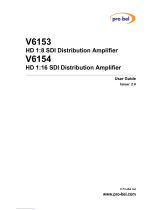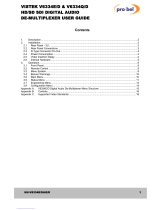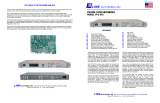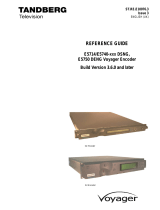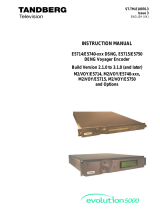Page is loading ...

VISTEK V1667, V1667/SY & V1667/SY-VHS
12-bit pal/ntsc to sdi adaptive
comb filter decoder
2 Issue 3
Contents
1. GENERAL DESCRIPTION........................................................................................4
2. INSTALLATION.........................................................................................................5
2.1 Rear Panel Layout and Signal Connections..................................................5
2.2 Frame Synchroniser Module (Optional).........................................................6
2.3 Frame Synchroniser Delay..............................................................................6
2.4 Insertion Delay.................................................................................................6
3. FRONT PANEL LAYOUT..........................................................................................7
3.1 Page/Parameter Map.......................................................................................8
4. FRONT PANEL DESCRIPTION (NORMAL OPERATION).......................................9
4.1 +V Indicator......................................................................................................9
4.2 REM Indicator...................................................................................................9
4.3 Video Standard Indicators / Selection of Video Standard............................9
4.4 Parameter Indicators and Adjustment...........................................................9
4.5 Remote / Local Switch..................................................................................10
5. TIMING PAGE (FRAME SYNCHRONISER)............................................................11
5.1 Timing Page Entry.........................................................................................11
5.2 Timing Parameter Selection and Adjustment..............................................11
5.3 Timing Page Exit............................................................................................12
6. ENGINEERING PAGE.............................................................................................13
6.1 Engineering Page Entry................................................................................13
6.2 Engineering Parameter Selection and Adjustment.....................................13
6.3 Engineering Page Exit...................................................................................14
7. TECHNICAL SPECIFICATION................................................................................15
8. APPENDIX...............................................................................................................16
8.1 On Board Adjustable Components..............................................................16
8.2 On Board Switches........................................................................................16
8.3 VHS Input Option...........................................................................................17
8.3.1 Selection of VHS Decode Mode.........................................................17
8.3.2 Parameter Selection and Adjustment.................................................18

VISTEK V1667, V1667/SY & V1667/SY-VHS
12-bit pal/ntsc to sdi adaptive
comb filter decoder
HU-V1667&SY&SY-VHS 3
8.4 An Introduction to Vislock Processing........................................................18
8.4.1 What is VisLock?................................................................................18
8.4.2 How does it work?...............................................................................18
8.4.3 Does the added data degrade my picture?.........................................19
8.4.4 Will digital equipment in the path pass the VisLock signal?................19
8.4.5 How is VisLock Implemented?............................................................19

VISTEK V1667, V1667/SY & V1667/SY-VHS
12-bit pal/ntsc to sdi adaptive
comb filter decoder
4 Issue 3
1. GENERAL DESCRIPTION
The V1667 is a 12 bit broadcast quality multi-standard adaptive comb filter decoder, and forms part of the
Vistek V1600 modular range of interface products. The 3U x 250mm card may be fitted into either the V1601
(1U) or V1603 (3U) 19” rack mountable enclosures, from which it derives its power. All signal inputs and
outputs are made via a passive rear module.
In its basic form, without a Frame Synchroniser fitted (V1667 product), the unit converts an analogue colour
encoded composite video input to a 270Mbit component Serial Digital Video (SDV) output standard.
One of two Frame Synchroniser modules may be optionally fitted to the decoder. The standard Frame
Synchroniser module (fitted on the V1667/SY product) permits the output of the unit to be timed up to an
external reference, with a user programmable offset of up to + 127 lines relative to the reference. The
alternative module (fitted on the V1667/SY-VHS product) has the same functionality of the standard
synchroniser module, but also offers the facility to decode non-timebase corrected signals, specifically the
output of a VHS tape recorder.
VisLock processing may be optionally factory fitted to the card. VisLock processing is a patented method of
converting an NTSC composite analogue signal to serial digital form (within the V1667), then subsequently
re-converting back to NTSC (within a Vistek V1668 encoder) with negligible loss of picture quality.
The V1667 has a high impedance looping input, into which the analogue colour encoded input is presented.
The card will detect, and consequently automatically decode, any of the standards listed below:-
PAL B, G, I, M, N
NTSC M, NTSC JAPAN
NTSC 443
The decoder may also be forced into any one of the specified standards, although it is generally
recommended that the user leave the card set in automatic (AUTO) mode.
The V1667 has four 270Mbit component Serial Digital Video (SDV) outputs.
Front panel controls enable the user to set up/adjust various operating parameters, and if a Frame
Synchroniser option is fitted they may be used to time the unit into an installation.
All parameter settings, for each standard, are stored in non-volatile memory. Thus a unit may be powered
down without the settings being lost.

VISTEK V1667, V1667/SY & V1667/SY-VHS
12-bit pal/ntsc to sdi adaptive
comb filter decoder
HU-V1667&SY&SY-VHS 5
2. INSTALLATION
2.1 Rear Panel Layout and Signal Connections
SD
(IN)
SD 1
(OUT)
SD 2
SD 3
1
2
3
4
5
SDI Output 2
SDI Output 3
Analogue Composite Video (CVBS)
Looping Input
Reference Input to Synchroniser (If fitted)
DELAY - TTL O/P from Synchroniser (If fitted)
SDI Output 1
SDI Output 4
Looping Input
BNC Connector
Input / Output
Description
Comments
SD (IN) SDI Output 1 Cable drive length:- up to 200 metres.
SD 1 (OUT) SDI Output 2 Cable drive length:- up to 200 metres.
SD 2 SDI Output 3 Cable drive length:- up to 200 metres.
SD 3 SDI Output 4 Cable drive length:- up to 200 metres.
BNC 1 Delay O/P (TTL) Only valid when a synchroniser sub-module is fitted.
BNC 2 CVBS High impedance looping input.
BNC 3 Looping Input
BNC 4 Reference High impedance looping reference input.
BNC 5 Looping Input Only valid when a synchroniser sub-module is fitted.

VISTEK V1667, V1667/SY & V1667/SY-VHS
12-bit pal/ntsc to sdi adaptive
comb filter decoder
6 Issue 3
2.2 Frame Synchroniser Module (Optional)
A Frame Synchroniser module may be optionally fitted to the V1667. It is located into sockets P1, P2, P3 and
P4. Its presence is automatically detected by the on board micro-processor and is consequently integrated
into the signal processing path.
With a Frame Synchroniser fitted, the user may adjust the V1667 output timing relative to the reference input
by up to a maximum offset of + 127 lines. This operation is described in Section 5.2 Timing Parameter
Selection and Adjustment.
If a Frame Synchroniser module is fitted, but there is no reference input, then the decoder will enter a
minimum delay mode. In this mode the synchroniser is bypassed, and the delay through the unit is fixed at
7µs.
See Section 8.3 VHS Input Option for a description of the VHS frame synchroniser option.
2.3 Frame Synchroniser Delay
When the Frame Synchroniser option is fitted there is a TTL output signal to indicate the amount of extra
delay inserted above the minimum as specified for the unit. The signal has a constant period of two frames
and a variable mark space ratio which depends on the amount of delay inserted. The HIGH portion of the
signal indicates the delay.
A typical waveform is as shown below:
DELAY
2 FRAMES
Note: If the input and reference signals are asynchronous then the width of the delay pulse will vary,
and will be dependent on the relative timing of the two signals.
2.4 Insertion Delay
The insertion delay through the V1667 is dependent on whether a Frame Synchroniser option is fitted.
Without a Frame Synchroniser it is deterministic and fixed. With the Frame Synchroniser fitted there is a
delay range, and the absolute delay will be dependent on the relative timing between the input video signal
and the reference input.
In each case the delay is measured between the composite video input and the input to the SDI serialiser.
Condition Unit Delay
V1667 + No Frame Synchroniser Module 7µs
V1667 + Frame Synchroniser Module 7µs (Minimum)
1 Frame + 7µs (Maximum)

VISTEK V1667, V1667/SY & V1667/SY-VHS
12-bit pal/ntsc to sdi adaptive
comb filter decoder
HU-V1667&SY&SY-VHS 7
3. FRONT PANEL LAYOUT
See Section 8.3 VHS Input Option for a description of the VHS decoding option.
REM +V
NTSC
443
Local
Rem
V1667
12 Bit Decoder
CVBS to SDI
Select
CAL
+
-
I
M
N
Std.
VGain
CGain
Phase
Setup
PAL
Remote Control Access and Power indicators
Standard and Page indicators
Parameter indicators:
SELECT Button
UP Button
CAL / NORMALISED LED
DOWN Button
REMOTE / LOCAL control selection
AUTO
UNCAL LED (+)
UNCAL LED (-)
A
B
C
D
E
Sig
Tim
Anc
Named for Top Page
A - E for other Pages
VHS
VHS input selection:-
Only available on V1667/SY-VHS product
The V1667 has a versatile front panel, shown above. Commonly used controls are directly available, whilst
the less used ones are protected from inadvertent use. The panel uses the concept of Pages and
Parameters. Within each Page there are a possible 5 adjustable Parameters.
There is provision for 5 pages in total, although only 3 are currently used. These are:
Top page (normal operation) This is the normal operating page. The unit will always enter this page at
power up.
See 4. FRONT PANEL DESCRIPTION (NORMAL OPERATION)
Timing Page This page is used to adjust the Frame Synchroniser timing parameters
and input failure modes, and is accessible only when a Frame
Synchroniser module is fitted to the card.
See 5. TIMING PAGE (FRAME SYNCHRONISER)
Engineering Page This page is used to make changes to the decoder processing that it is
considered the user will only need to access infrequently (VITS
pass/blank, etc..)
See 6. ENGINEERING PAGE

VISTEK V1667, V1667/SY & V1667/SY-VHS
12-bit pal/ntsc to sdi adaptive
comb filter decoder
8 Issue 3
3.1 Page/Parameter Map
This table shows all the adjustable Parameters in each Page. It may be convenient to keep a copy close to
the equipment.
Top Page Page 1 (SIG) Page 2 (TIM) Page 3 (ANC) ENG.
A Standard V Timing NTSC type
B Video Gain H Timing Vertical interval
C Chroma Gain Sync. I/P fail mode
VisLock1
D Phase Minimum delay Delay line PAL
E Setup/Black Timing Reset Chroma B/W
1 This control is available only if the VisLock option has been factory fitted to the card. See Section 8.4 An
Introduction to Vislock Processing for a description of the VisLock processing option.

VISTEK V1667, V1667/SY & V1667/SY-VHS
12-bit pal/ntsc to sdi adaptive
comb filter decoder
HU-V1667&SY&SY-VHS 9
4. FRONT PANEL DESCRIPTION (NORMAL OPERATION)
See Section 8.3 VHS Input Option for a description of the VHS decoding option.
4.1 +V Indicator
This is a green LED that is illuminated when the module is powered.
4.2 REM Indicator
This yellow LED is illuminated when the module is accessed by the DART remote control system.
4.3 Video Standard Indicators / Selection of Video Standard
This is a bank of six yellow LEDs which indicate the operating standard and the status of the input signal.
Please note that selection of the video standard via the front panel may only be achieved if the Local /
Remote switch is set to Loc. When it is set to Rem there is a front panel lockout condition.
Selection of the operating standard is made by first pressing the Select button until the green Standard
parameter LED is illuminated, then secondly by pressing the Up or Down buttons (▲ or ▼ respectively) to
select the desired standard of operation.
The software allows the user to force any one standard, depicted by the relevant LED being illuminated, or to
enter an automatic detect and decode mode, whereby the AUTO LED will be illuminated together with the
relevant detected standard LED.
If there is no input signal present, or if the input signal is of poor quality, then the decoder will indicate this by
flashing the selected standard LED when in force mode. When in automatic mode the AUTO LED will flash
and none of the standard LEDs will be illuminated.
4.4 Parameter Indicators and Adjustment
There are five parameters that may be adjusted by the decoder in the Top Page. These are the video
standard, video gain, chrominance gain, demodulation phase and setup/black level. The row of five green
parameter LEDs indicate which parameter has been selected, and the status of the non-selected
parameters.
Please note that selection and adjustment of any video parameter via the front panel may only be achieved if
the Local / Remote switch is set to Loc. When this switch is set to Rem there is a front panel lockout
condition.
Selection of the parameter to be adjusted is made by repeatedly pressing the Select button until the relevant
green parameter LED is illuminated. The software cycles through each parameter in turn plus a sixth
‘dummy’ position, within which no parameter is selected (no LED illuminated). This helps to prevent
accidental mis-alignment of a parameter.
After selecting the desired parameter, adjustment is made by using the Up and Down buttons (▲ or ▼
respectively). If the selected parameter is adjusted away from the calibrated position the green Cal LED will
be extinguished, and one of the red LEDs (+ or -) will be illuminated, dependent on whether the chosen
parameter has increased or decreased (Note: any non-selected parameter that has been adjusted away from
its calibrated position will flash at low duty cycle). To reset the selected parameter to its calibration position
depress the Up and Down buttons (▲ or ▼) simultaneously.

VISTEK V1667, V1667/SY & V1667/SY-VHS
12-bit pal/ntsc to sdi adaptive
comb filter decoder
10 Issue 3
Adjustment of the video standard (Standard) is described in the section entitled 4.3 Video Standard
Indicators / Selection of Video Standard.
Video gain (VGain) may be increased by pressing the Up button (▲) or reduced by pressing the Down
button (▼) . Video gain amplifies or attenuates all three of the component signals (Y, Cb, Cr) after the
demodulation process and each by the same ratio.
Video gain Max 200%
Cal. 100% Resolution 0.2 % steps
Min 0%
Chrominance gain (CGain) may be increased by pressing the Up button (▲) or reduced by pressing the
Down button (▼). Chroma gain amplifies or attenuates both of the colour difference signals (Cb, Cr) after the
demodulation process and by the same ratio.
Chroma gain Max 200%
Cal. 100% Resolution 0.2 % steps
Min 0%
Demodulation phase (Phase) may be adjusted either side of the calibration position by using the Up and
Down buttons (▲ and ▼).
Phase adj. Max +45°
Cal. 0° Resolution 0.3° steps (approx.)
Min -45°
The luminance output black level (Setup) of the signal may be adjusted either side of the calibration position
(0mV black level in all standards) by using the Up and Down buttons (▲ and ▼).
Setup Max +100mV
Cal. 0mV Resolution 0.75mV steps (approx.)
Min -100mV
Please note: this adjustment is made after a nominal 54mV pedestal has been removed from 525 line
standard inputs (excluding NTSC Japan).
4.5 Remote / Local Switch
The V1667 may be controlled locally via the front panel, hence this switch will be set to Local. Alternatively,
the card may be controlled via the DART remote control system, in which case the switch will be set to Rem.
When in the Rem position the front panel is locked out ie. it is not possible to modify the video standard or to
make signal parameter adjustments.

VISTEK V1667, V1667/SY & V1667/SY-VHS
12-bit pal/ntsc to sdi adaptive
comb filter decoder
HU-V1667&SY&SY-VHS 11
5. TIMING PAGE (FRAME SYNCHRONISER)
See Section 8.3 VHS Input Option for a description of the VHS decoding option.
5.1 Timing Page Entry
Press the Select button and hold in, followed by the Down (▼) button. Entry to the Timing Page will occur
immediately, and will be indicated by the Tim pair of LEDs (PAL M and 443) flashing simultaneously.
Note: The Timing Page may only be accessed if there is a Frame Synchroniser Module fitted to the card.
5.2 Timing Parameter Selection and Adjustment
There are 4 adjustable parameters defined in the Timing Page. These are defined in the table below:
Parameter
A V Timing Offset
B H Timing Offset
C Sync Fail Mode
D Minimum delay
E Timing Reset
Selection of the parameter to be adjusted is made by repeatedly pressing the Select button until the relevant
green parameter LED is illuminated. Then use the Up (▲) and Down (▼) buttons to adjust the chosen
parameter as defined below.
To reset the chosen parameter to its calibration position depress the Up (▲) and Down (▼) buttons
simultaneously.
The output of the decoder is vertically co-timed to the reference input when V Timing Offset is in the Cal.
position (Green Cal. LED illuminated). If required the output may be advanced or delayed with respect to the
reference by a maximum of 127 lines.
V Timing Offset Max +127 lines
Cal. 0 lines Resolution 1 line
Min - 127 lines
The output of the decoder is horizontally co-timed to the reference input when H Timing Offset is in the Cal.
position (Green Cal. LED illuminated). If required the output may be advanced or delayed with respect to the
reference by a maximum of + 1/2 line.
H Timing Offset Max + 1/2 line
Cal. 0 line Resolution 37 ns
Min - 1/2 line

VISTEK V1667, V1667/SY & V1667/SY-VHS
12-bit pal/ntsc to sdi adaptive
comb filter decoder
12 Issue 3
The Frame Synchroniser offers three modes of operation when the input signal fails/disappears (Sync Fail
Mode). These are:
Sync Fail Mode (▲) Freeze picture.
Cal. Freeze picture for 3 seconds, then cut to black
(▼) Cut to black.
The synchroniser sub-module may be bypassed by entering the Minimum Delay mode.
Minimum Delay Mode Cal. LED ON Force Minimum Delay.
OFF Normal synchroniser functionality.
All of the timing parameters may be reset to their respective normalised positions by following the procedure
described below:
1 Select the Timing Reset parameter.
2 Depress the Up (▲) and Down (▼) buttons simultaneously.
Successful timing reset will be indicated by the Timing Reset LED (D) being extinguished and the V Timing
Offset LED (A) illuminating.
5.3 Timing Page Exit
Press the Select button, followed by the Down (▼) button. The decoder will exit the Timing Page
immediately, and resume normal front panel operation.
If the unit is left in the Timing Page for more than five minutes, during which no button has been pressed,
then the decoder will timeout from this mode and revert to normal front panel operation.

VISTEK V1667, V1667/SY & V1667/SY-VHS
12-bit pal/ntsc to sdi adaptive
comb filter decoder
HU-V1667&SY&SY-VHS 13
6. ENGINEERING PAGE
See section 8.3 VHS Input Option for a description of the VHS decoding option.
6.1 Engineering Page Entry
Press the Select button and hold in, followed by the Down (▼) button. Keep both buttons depressed for 5
seconds until all six yellow standard LEDs become illuminated simultaneously. This indicates that the
decoder has entered the Engineering Page.
6.2 Engineering Parameter Selection and Adjustment
Scroll around the five parameters using the Select button. The engineering parameter functions may be
switched ON and OFF by using the Up and Down (▲ and ▼) buttons respectively. Engineering parameters
are defined as:-
Parameter
(Panel Legend)
Cal.
LED
Engineering Page
Parameter Function
Comments
A ON
OFF
NTSC
NTSC Japan
Default (1)
B ON
OFF
Pass vertical interval data
Blank vertical interval data
Default 625
Default 525
C ON
OFF
VisLock processing enabled
VisLock processing disabled
Default (2)
D ON
OFF
Adaptive delay line PAL
Simple PAL
Default all PAL standards
Default all other standards
E ON
OFF
Chrominance band pass filter. (3)
All 5 LEDs Depress the + and - buttons for 5 seconds for Factory Initialisation of all parameters
in all standards (except timing parameters, which may be normalised within the timing
page). After successful Factory Initialisation the decoder will automatically resume
normal front panel operation.
(1) NTSC or NTSC Japan selection is only available when in the NTSC standard setting.
(2) See Section 8.4 An Introduction to Vislock Processing for a description of the VisLock processing
option. This control is available only if the VisLock option has been factory fitted to the card.
(3) Use the Up and Down (▲ and ▼) buttons to adjust the bandwidth of the chrominance band pass filter.
Adjustment range is between 1 (narrowest) and 6 (widest), and is indicated by the +, Cal. and – LEDs.
LED Filter 1 Filter 2 Filter 3 Filter 4 Filter 5 Filter 6
+ OFF OFF OFF ON ON ON
Cal. OFF ON ON OFF OFF ON
- ON OFF ON OFF ON OFF

VISTEK V1667, V1667/SY & V1667/SY-VHS
12-bit pal/ntsc to sdi adaptive
comb filter decoder
14 Issue 3
6.3 Engineering Page Exit
Press the Select button, followed by the Down (▼) button. The decoder will exit the Engineering Page
immediately, and resume normal front panel operation. If the unit is left in the engineering page for more
than five minutes, during which no button has been pressed, then the decoder will timeout from this page and
revert to normal front panel operation.

VISTEK V1667, V1667/SY & V1667/SY-VHS
12-bit pal/ntsc to sdi adaptive
comb filter decoder
HU-V1667&SY&SY-VHS 15
7. TECHNICAL SPECIFICATION
Analogue Input (Looping)
Format PAL B, G, I, M, N, NTSC M, NTSC Japan, NTSC 443
Level 1V p-p composite (terminated)
Connector BNC
Impedance 75Ω (external)
Return loss > 35dB to 5.5MHz
Reference Input (Frame Synchroniser fitted)
Format PAL B, G, I, M, N, NTSC M, NTSC Japan, NTSC 443
Level Standard level Black and Burst (or 1V p-p composite)
Connector BNC
Impedance 75Ω (external)
Return loss > 35dB to 5.5MHz
Serial (SDV) Outputs (4)
Format EBU Tech.3267 ANSI / SMPTE T14.22/082
Data rate 270 Mb/s
Connector BNC
Impedance 75Ω
Return loss > 15dB 5-270MHz
Amplitude 800mV p-p (terminated)
DC offset 0V +/- 0.5V
Rise and fall times 0.75-1.5 ns
Jitter < 0.2 UI p-p
Drive length up to 250m (Belden 8281)
Video Performance
(These figures to not apply when in VHS decode mode on the V1667/SY-VHS product).
Y frequency response < 0.2dB to 5.5MHz
Y non-linearity < 1.0 %
Chrominance non-linearity < 1.0 %
2T pulse < 1 % K
2T pulse / bar < 0.5 % K
Chroma/luma timing error < 7 ns
Subcarrier rejection > 45 dB
Signal to noise ratio > 68 dB (weighted)
Miscellaneous
Power consumption 8W approx. Frame Synchroniser NOT fitted.
10W approx. Frame Synchroniser fitted.
Insertion delay 7µs Frame Synchroniser NOT fitted.

VISTEK V1667, V1667/SY & V1667/SY-VHS
12-bit pal/ntsc to sdi adaptive
comb filter decoder
16 Issue 3
8. APPENDIX
8.1 On Board Adjustable Components
Circuit Reference Description
VR1 Syncs to picture timing alignment.
VR2 625/525 line standard discrimination.
VR3 Luminance gain alignment:- 525 input
VR4 Luminance gain alignment:- 625 input
Note: The table above is included for information only. Users are strongly advised not to adjust these
components, as to do so may mis-align the related function.
Location of on-board adjustable components
VR1 VR2
VR3
VR4
Front
Panel
Edge
Connector
8.2 On Board Switches
Switch Position Description
SW5-1 ON Not used
OFF
SW5-2 ON Not used
OFF
SW5-3 ON Modified adaption algorithm.
OFF Standard adaption algorithm:- normal position.
SW5-4 ON Not used
OFF

VISTEK V1667, V1667/SY & V1667/SY-VHS
12-bit pal/ntsc to sdi adaptive
comb filter decoder
HU-V1667&SY&SY-VHS 17
8.3 VHS Input Option
This option is available ONLY on the V1667/SY–VHS product.
DEC 2
9 bit notch type
VHS decoder
V1667/SY-VHS Product:- Functional Block Diagram
DEC 1
12 bit adaptive
broadcast quality
decoder
Frame
Synchroniser
Processing Block
Reference
Input
Analogue
Composite
Video Input
10 bit parallel
D1 data
8 bit parallel
D1 data
SW1
broadcast / VHS
mode switch
sync on / off
selection switch
to D1
serialiser
VHS synchroniser
sub-module
The difference between the VHS and standard frame synchroniser modules is the inclusion of a second
decoder (DEC 2 in the block diagram above) and a broadcast / VHS mode switch (SW1 above).
This second decoder has a 9 bit ADC at its input, and produces an 8 bit parallel D1 output. It has a wide
pulling range on its clock generation phase locked loop, which allows it to lock to and decode the output of a
VHS tape recorder. It offers a simple notch type decoding architecture, which is ideally suited to this
application. Furthermore, DEC 2 has been configured to apply automatic gain control (Video AGC) and
automatic chrominance gain control (ACGC) to the input signal, as the output from a typical VHS recorder
can vary greatly on its nominal luminance and chrominance gain levels.
Switch SW1 allows selection between broadcast and VHS decoding modes, to suit the application. The user
is advised to select the output from the VHS decoder (DEC 2) only when non-timebase corrected signals
(typically VHS recorder outputs) are applied to the unit. Under ALL other input conditions the output from the
normal (broadcast) decoder should be selected, as the processing performance (linearity, SNR, picture
quality, etc..) is far superior.
Please note that the VHS decoder block (DEC 2) will only function with either PALI or NTSC input standards.
8.3.1 Selection of VHS Decode Mode
Ensure the decoder is in the top page of normal (broadcast) decode mode front panel operation, and that no
parameter is selected.
Depress the Select and Up (▲) buttons simultaneously.
Keep both buttons depressed for approximately 1 second until the +, Cal and - LEDs become illuminated
simultaneously. This indicates that the decoder has entered the VHS decode mode.
To return to normal (broadcast) decode mode repeat the procedure described above.

VISTEK V1667, V1667/SY & V1667/SY-VHS
12-bit pal/ntsc to sdi adaptive
comb filter decoder
18 Issue 3
8.3.2 Parameter Selection and Adjustment
This table shows all the adjustable Parameters in each Page when in VHS decode mode.
Top Page Page 1 (SIG) Page 2 (TIM) Page 3 (ANC) ENG.
A V Timing
B H Timing
C
D
E Timing Reset
There are NO adjustable parameters within the top page of VHS front panel operation (ie video gain,
chroma gain, setup and phase are not selectable or adjustable). The VHS decoder chip has been forced into
Automatic Gain Control (AGC) and Automatic Chrominance Gain Control (ACGC) modes, hence these
picture adjustments are not available.
To enter the timing page of VHS front panel operation follow the procedure described in Section 5.1 Timing
Page Entry.
There are two adjustable parameters within the timing page of VHS front panel operation. These are V
timing offset and H timing offset. Adjustment ranges for these two parameters are the same as in normal
(broadcast) decode mode.
8.4 An Introduction to Vislock Processing
8.4.1 What is VisLock?
Vislock is a patented method of converting an NTSC composite analogue signal to serial digital form then
subsequently re-converting back to NTSC with negligible loss of picture quality. This enables digital and
analogue plant to be mixed in a high quality installation.
8.4.2 How does it work?
When a composite NTSC signal is decoded it is split into its luminance and colour difference components.
This process is never perfect, even using the highest quality decoders, and in practice some of the
luminance picture information passes into the colour difference path. This results in spurious colour effects
known as cross-colour. Also, some of the subcarrier used to convey the colour information in the original
NTSC inevitably passes into the decoded luminance. This may appear as a moving dot pattern on vertical
edges of coloured areas or “hanging dots” on horizontal edges.
After repeated decoding and re-encoding processes these effects increase, and the final signal may suffer
significant loss of both luminance and chrominance resolution.
In the decoder the Vistek VisLock system embeds subliminal data information into its serial digital output.
This data passes with the video signal to downstream encoders and provides them with information about
the original NTSC signal. By using this information the encoder can re-assemble the NTSC signal exactly in
the same way as it was separated.

VISTEK V1667, V1667/SY & V1667/SY-VHS
12-bit pal/ntsc to sdi adaptive
comb filter decoder
HU-V1667&SY&SY-VHS 19
Because of the precise separation of luminance and chrominance in the V1667 it is possible to re-assemble
the NTSC signal without any significant loss of quality, even after repeated decoding and re-encoding
processes.
8.4.3 Does the added data degrade my picture?
The data is transmitted outside the analogue NTSC picture area and at a very low level. This ensures it is
invisible to the viewer of the digital image.
8.4.4 Will digital equipment in the path pass the VisLock signal?
As the Vislock data is integrated within the active picture area of the serial digital video signal, it is
transmitted accurately through most professional digital video plant including switchers, routers,
synchronisers, audio embedders and de-embedders, caption and logo inserters etc.
Certain equipment such as standards converters and effects generators may destroy the relationship
between subcarrier and line frequency such that after processing it is impossible to accurately re-assemble
the NTSC signal. However, these units often significantly reduce many of the re-encoding impairments.
8.4.5 How is VisLock Implemented?
The Vistek V1667 decoder and V1668 encoder modules are now available with VisLock, no additional
equipment is required. The V1667 decoder converts the NTSC to serial digital (SDI) format and inserts the
VisLock data. When the serial digital signal is subsequently converted back to NTSC in a VisLock compatible
V1668 encoder the added data is read and the signal timed to ensure that optimum encoding quality is
achieved and the signal timed to the genlock reference signal.
/

